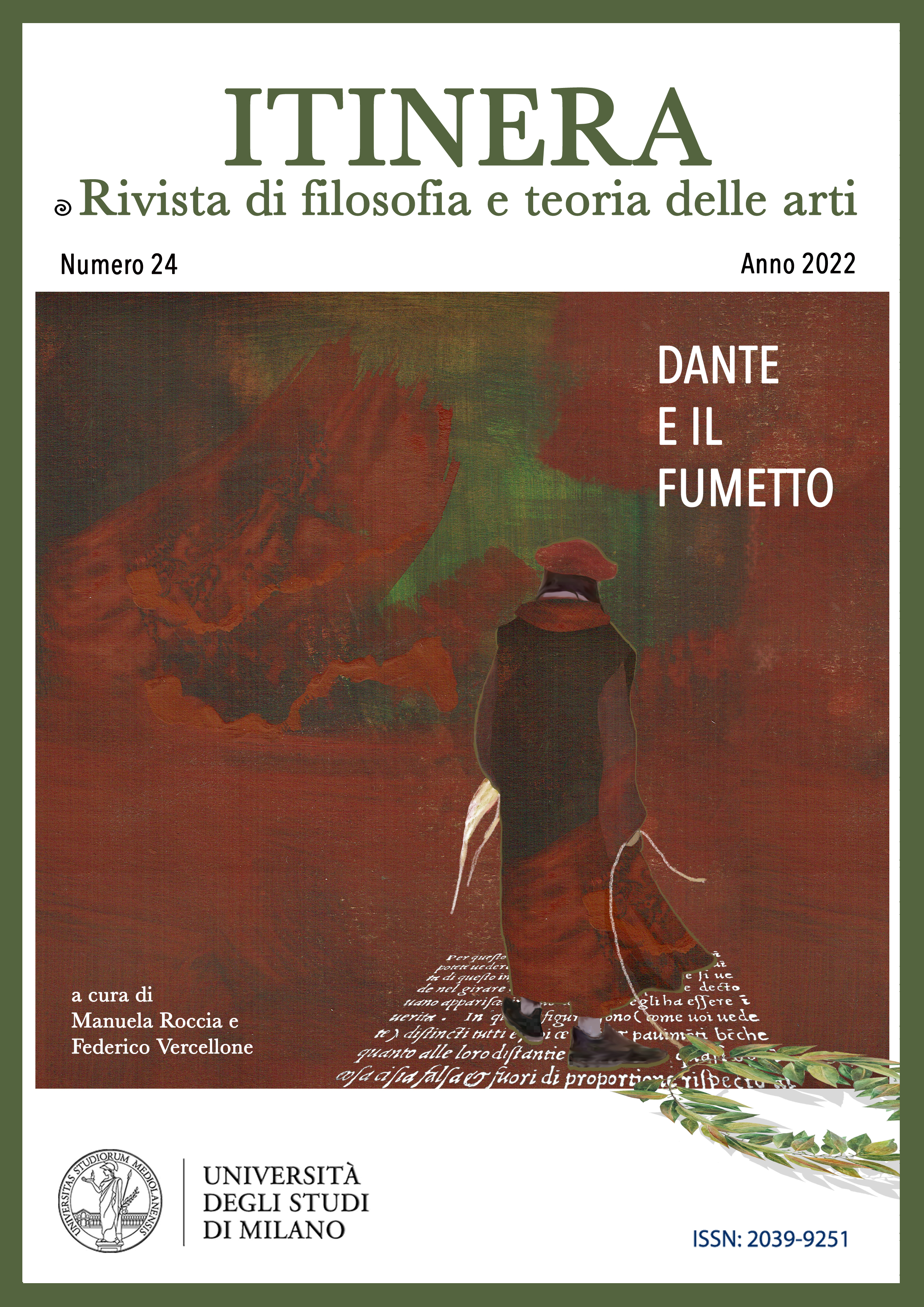La Commedia tra testo e immagine: breve viaggio nella letteratura dantesca a fumetti
DOI:
https://doi.org/10.54103/2039-9251/19756Parole chiave:
Comics, illustrations, Divine Comedy, reinterpretation.Abstract
Dante Alighieri's Divine Comedy is rich in visual and imaginative suggestions, capable of intertwining in total harmony with words and triplets in alternating rhyme, giving life to a unique and fascinating work. Over the centuries, the “divine poem” has inspired generations of authors and artists, who have re-proposed Dante's journey into the afterlife through different languages and expressive codes, first of all representative art. Above all, the visual and artistic translations of Dante’s work have influenced many writers and cartoonists who, starting from lithographs and ancient tables - think of the Divine Comedy illustrated by Gustave Doré in the second half of the nineteenth century - have developed their own transposition of the poem, in the wake of innovation and experimentation.
In fact, the tradition of Dante in comics has its roots in the early twentieth century and knows an extraordinary development throughout the century both in Italy and abroad. From Disney’s Mickey’s Inferno to Marcello Toninelli’s Divine Comedy, from Go Nagai’s monumental manga work to Hunt Emerson’s Dante’s Inferno, Dante's triplets capture the attention of comic book fans all over the world, presenting themselves not only as an interesting reading for pleasure, but also as an effective didactic-pedagogical tool for students. In fact, the comic is not only synonymous with entertainment, but also a means capable of adapting the complex content of the Divine Comedy to an audience of primary school pupils, from which it is possible to start a profitable didactic planning, which sees protagonists and “cartoonists” the children themselves.
Riferimenti bibliografici
Alighieri, D., La Divina Commedia, Camerini, E (a cura di) e illustrata da Doré, G., European Book, Milano 2011.
Barbieri, D., Breve storia della letteratura a fumetti, Carocci Editore, Roma 2019.
Carboni, S. (a coordinamento editoriale di), L’Inferno di Topolino e altre storie ispirate a Dante Alighieri, Giunti Editore, Milano 2016.
Catelli, N. e Rizzarelli, G. (a cura di), Poemi a fumetti. La poesia narrativa da Dante a Tasso nelle trasposizioni fumettistiche, in "Rivista Internazionale di Studi su Letteratura e Visualità" Arabeschi 2016, n.7, www.arabeschi.it/introduzione-a-poemi-fumetti-la-poesia-narrativa-da-dante-tasso-nelle-trasposizioni-fumettistiche/.
D’Uva, A., Rossi, F. & Astrid, Dante Alighieri. “Amor mi mosse”, Kleiner Flug, Firenze 2018.
Fecchio, E., Carboni, S. (a coordinamento editoriale di), PaperDante, Giunti Editore, Milano 2021.
Lange, H. e Lange, K., Dante per chi ha fretta, Salani, Milano 2015.
Nagai, G., La Divina Commedia. Omnibus, Edizioni BD, Milano 2019.
Nembrini, F. (a cura di) e Dell’Otto, G. (illustrato da), Dante Alighieri. Inferno, Mondadori, Milano 2018.
Toninelli, M., Dante. La Divina Commedia a fumetti, Shockdom, Brescia 2015.
Tornotti, G. (a cura di), La mente innamorata. La Divina Commedia di Dante, Pearson Paravia Bruno Mondadori, Padova 2009.
Tosti, A., Graphic novel. Storia e teoria del romanzo a fumetti e del rapporto fra parola e immagine, Tunuè 2016.
Saez de Adana, F., An interview with Hunt Emerson, in "Rivista Dante e l’arte" 2018, n.5, https://ddd.uab.cat/pub/dea/dea_a2018v5/dea_a2018v5p263.pdf.
Sones, W.W.D., The comics as an Educational Medium, in "Journal of Educational Sociology" 1944, Vol.18, n.4, American Sociological Association, www.jstor.org/stable/2262696.
Sitografia
https://disney-comics.fandom.com/it/wiki/Inferno_di_Topolino.
Dowloads
Pubblicato
Fascicolo
Sezione
Licenza
Gli autori che pubblicano su questa rivista accettano le seguenti condizioni:
1. Gli autori mantengono i diritti sulla loro opera e cedono alla rivista il diritto di prima pubblicazione dell'opera, contemporaneamente licenziata sotto una Licenza Creative Commons - Attribuzione - Condividi allo stesso modo 4.0 internazionale che permette ad altri di condividere l'opera indicando la paternità intellettuale e la prima pubblicazione su questa rivista.
2. Gli autori possono aderire ad altri accordi di licenza non esclusiva per la distribuzione della versione dell'opera pubblicata (es. depositarla in un archivio istituzionale o pubblicarla in una monografia), a patto di indicare che la prima pubblicazione è avvenuta su questa rivista.
3. Gli autori possono diffondere la loro opera online (es. in repository istituzionali o nel loro sito web) prima e durante il processo di submission, poiché può portare a scambi produttivi e aumentare le citazioni dell'opera pubblicata (Vedi The Effect of Open Access).





